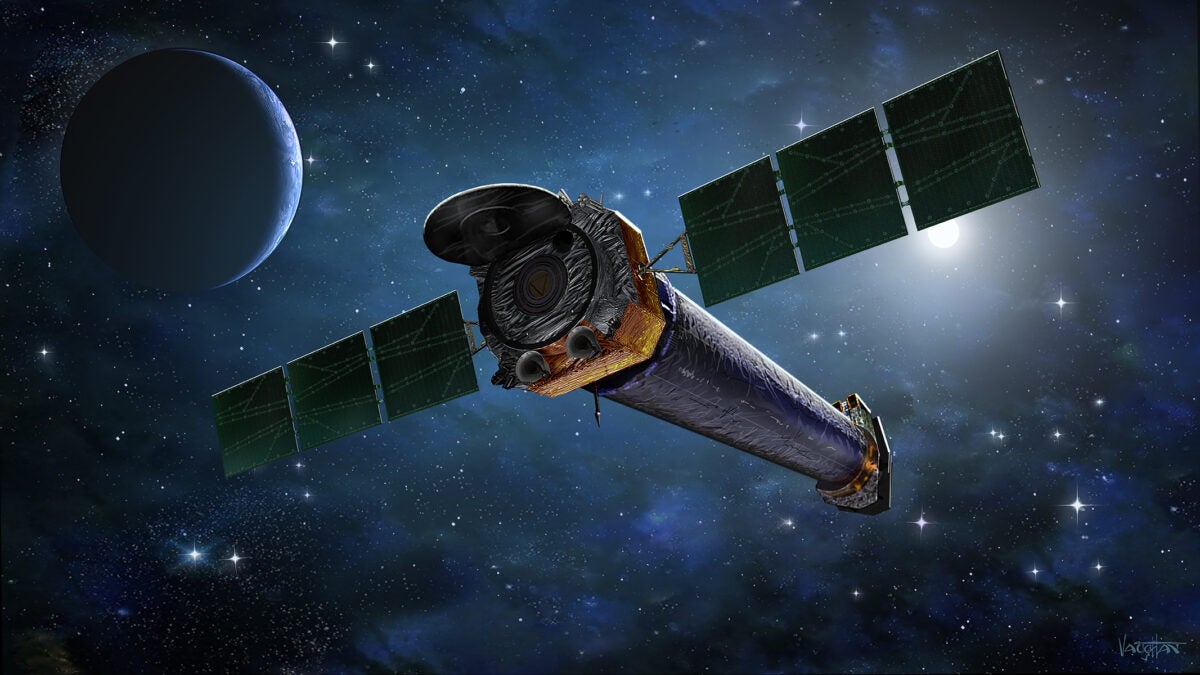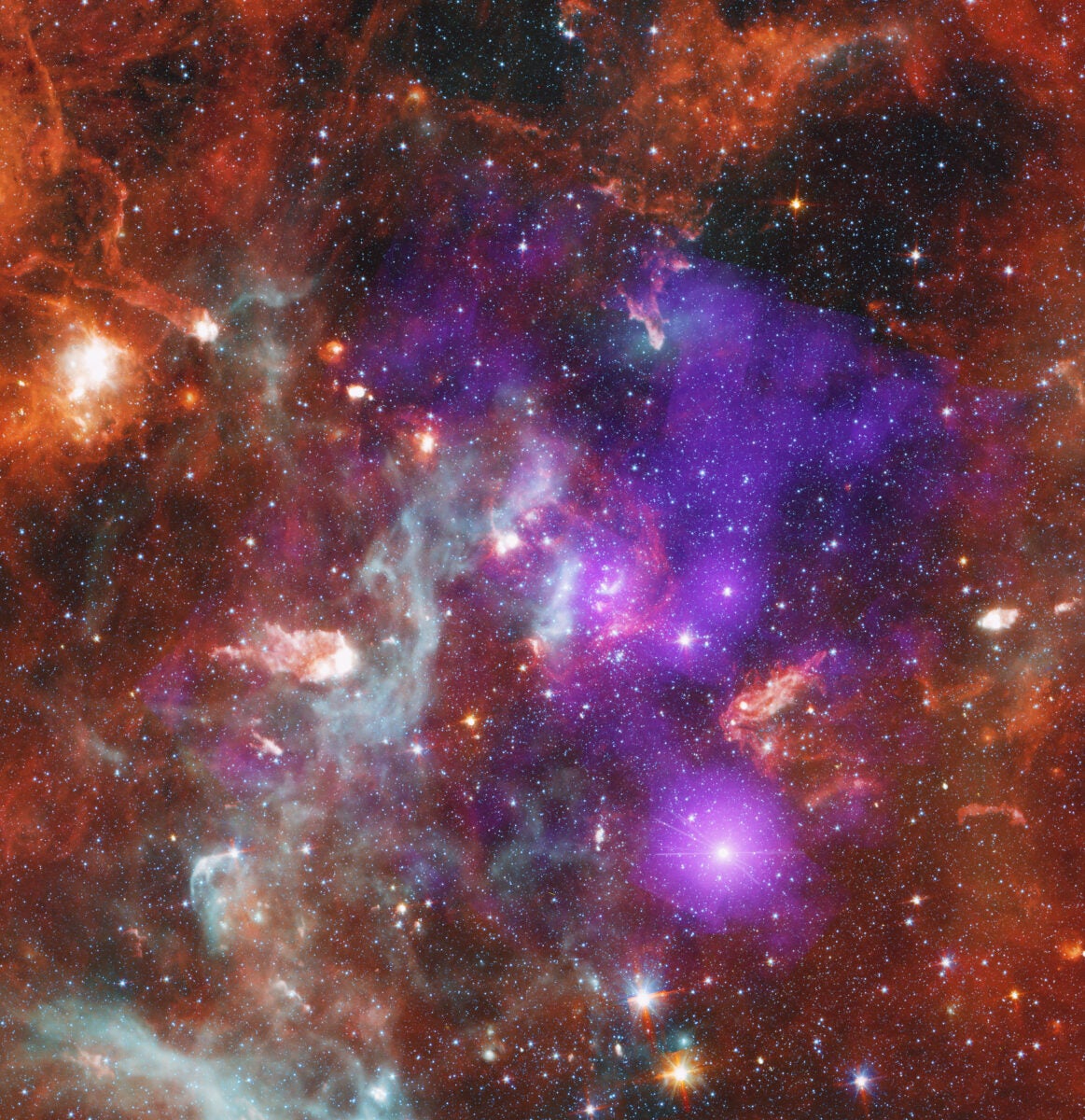Scientists are relieved by the observatory’s stay of execution, but concerned that some budget cuts have gutted future research.

The Chandra X-ray telescope, seen here in an artist’s rendition, remains in good health after 25 years of operations. Credit: NASA/James Vaughan
Scientists breathed a collective sigh of relief last week when NASA announced that the Chandra X-ray Observatory had been spared the chopping block — at least for another year. It was an abrupt about-face from plans announced in March to decommission the space-based telescope by this December.
Much of the credit for the 11th-hour stay of execution goes to a grassroots movement that dramatically demonstrated how public opinion can impact science funding. After receiving word last spring that Chandra was slated for termination, scientists and the public erupted in protest. Organized in part under the banner and hashtag of #SaveChandra, letters, petitions, and phone calls poured into Congress.
By July, appropriations committees in both the House and Senate had issued symbolic budget proposals. The Senate committed $72 million (which would represent full funding) toward Chandra’s “transformative discoveries” and the House introduced an authorization bill directing NASA to “take no action to reduce or otherwise preclude continuation” of Chandra before the agency’s three-year review late next year.
While the 2025 federal budget remains in limbo and will not be approved any sooner than January, congressional pushback has apparently made a difference. An announcement was expected from NASA in September, but no further information was revealed until an Oct. 23 virtual town hall meeting, when NASA astrophysics division director Mark Clampin said that key decisions on Chandra’s future will not be made until after Congress appropriates funds for the 2025 fiscal year.
That amounts to a temporary reprieve for the observatory. Clampin confirmed during the meeting that Chandra would receive enough funding for the coming year to perform much of its science and that there would be no immediate further layoffs. Sixty-eight scientists and technicians, about 40 percent of Chandra’s entire staff, had been slated for termination by the end of November.
Even before the cancellation threat, the observatory had already suffered cuts to its operating budget, including as recently as last year. These required both the layoffs of some staff and a significant reduction to so-called general observer and archival research funding that the mission awards to the astronomical community throughout the U.S. every year.
Scientists say that archival funding — which supports efforts to analyze and find results hidden in existing data — is an important part of the mission’s overall scientific return.
“NASA made the decision not to restore full funding to the scientists who analyze Chandra data or develop the theories to help understand the results,” notes David Pooley of Trinity University in San Antonio. “That support for the X-ray community has been flat for decades and is now half of what it used to be. This is having a devastating effect on the US X-ray astronomy community.”

Protecting a legacy
Chandra’s potential demise is especially galling to researchers because the telescope continues to operate normally and is capable of observations at resolutions no other X-ray observatory can obtain. Patrick Slane, director of the Chandra X-ray Center in Cambridge, Massachusetts, says whether or not Chandra earns a more lasting extension comes down to NASA’s priorities.
“It isn’t really a question of how important Chandra is to the community, how healthy Chandra is, or how productive it continues to be,” he wrote in an email to Astronomy. “These are all quite well known. The question is how NASA will prioritize their support for their portfolio of initiatives, some of which are operating and some of which involve plans for the future.”
Both Chandra and the Hubble Space Telescope are more than 25 years old. While the venerable pair continue to produce vital science, they are competing with newer projects that require increasingly larger slices of the budgetary pie. As budgets become more squeezed, both telescopes may eventually be operating on borrowed time.
Astrophysicists like Laura Lopez of the Ohio State University hope that day is far off. Chandra remains crucial to her research, and has been throughout the 20 years she has studied X-ray emitting objects, from supernovae to quasars. As co-principal investigator of the upcoming Chandra Legacy Program — which she describes as one of the deepest programs ever attempted with Chandra — Lopez says she is relieved but fearful of future cutbacks.
“We’re just happy that no one had to be laid off and that they’re going to be taking new data,” she says. “Just knowing that it’s able to continue is a big deal since there’s nothing on the horizon that can do anything similar scientifically.”
The Chandra Legacy Program will be looking at two huge galactic evolution engines: the baryon energy cycle — the exchange of matter between interstellar gas clouds and stars that drives galaxy formation — and energy feedback from supermassive black holes at the center of “active” galaxies in galaxy clusters. It will require two years of sustained funding to complete.
While Lopez and some other scientists remain concerned, Slane voices reserved optimism. “The very significant reductions in the budget guidelines received earlier this year were unanticipated and remain an issue of concern for the future,” he says, “but we are hopeful that the Senior Review process will lead to continued healthy support for Chandra,” referring to a NASA process that weighs the scientific value of various programs.
If the vocal and numerous supporters who wrote Congress have any say, Chandra may yet obtain a second lease on life.

